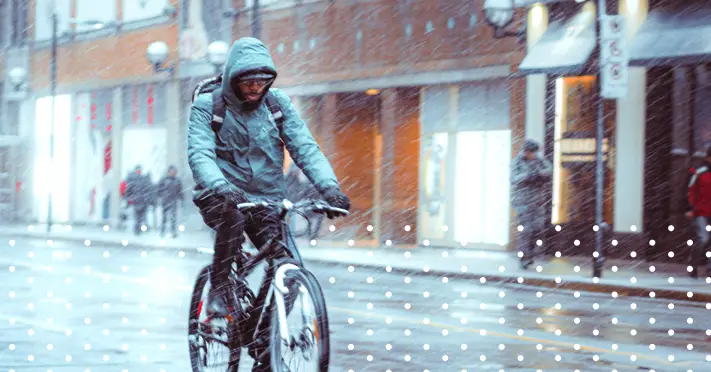The ability to operate an electric bike safely in the rain has become more relevant for riders across the country as electric bikes grow in popularity and more people use them as a primary mode of transportation.
E-bikes are safe to ride in the rain, but it depends on the electric bike you’re using. Like other forms of transportation (such as cars) that incorporate electrical components or onboard computers, e-bikes are typically designed with a certain degree of water resistance. However, before taking your electric bike out into the next monsoon, you need to understand the level of performance you can expect from it in wet conditions. You should also take certain precautions and observe some best practices when riding in the rain.
In this article, we’ll make recommendations on how best to operate your e-bike in the rain, and how to ensure the safety of yourself and your ride. We’ll begin by discussing what level of rain protection you can expect from your e-bike.
Electric Bike Water Resistance and Rain Protection
When a product is labeled “waterproof”, it means no water can get in or out of it under most observable conditions. Electric bikes are “water-resistant” rather than waterproof. This means that e-bikes can get wet and still function normally.
But while it’s difficult for water to penetrate an e-bike’s seals to reach the sensitive components within, it’s not impossible. If this happens, the water may cause damage that could lead to operating problems and subsequently a need for repairs, the replacement of defective components, or serious maintenance.
To help you determine how water-resistant your electric bike actually is, there’s a formal rating system known as the Ingress Protection (IP) rating system. Developed by the International Electrotechnical Commission (IEC), the IP rating system uses a simple letter/number combination to classify the performance of an electric bike in the rain and its resistance to bombardment by solid particles.
Here’s how to decipher IP rating codes:
- The letters “IP” stand for Ingress Protection.
- The first number after IP indicates how much protection the e-bike has from solids, such as dirt and dust.
- The second number indicates how much protection the bike has from liquids, such as rainwater.
- An “X” after the IP indicates a material (solid or liquid) against which the electric bike has not been formally rated.
If you search online, you can find standardized tables of IP ratings for electric bikes and their electrical components. Alternatively, you can ask the bike manufacturer or any e-bike salesperson directly about an e-bike’s IP rating.
Whichever source you consult, the IP ratings you find will describe the following levels of protection:
The First Number in an IP Rating
- IP1-: The component housing provides protection against solid objects larger than 50 mm.
- IP2-: Electronics are protected against solid objects in a size range between 12.5mm and 50mm.
- IP3-: The system provides a shield against solid objects greater than 2.5mm (such as tools and thick wires).
- IP4-: Only objects smaller than 1mm can penetrate the casing of electronics.
- IP5-: All electronic components are protected against infiltration from tiny objects like dust.
- IP6-: “Dust-tight” protection from solids.
The Second Number in an IP Rating
- IP-1: Electronic components of the bike are protected against water formed as a result of condensation, or from vertically falling drops of liquid.
- IP-2: Even if the device is tilted to a 15° angle, droplets of water cannot gain entry into the system.
- IP-3: Rain protection ensures that water sprays at a 60° angle are locked to the surface of the bike.
- IP-4: Protection against water splashes from any direction.
- IP-5: The e-bike is resistant to water jets from any direction.
- IP-6: Protection against powerful water jets.
- IP-7: The e-bike can withstand a 30-minute submersion in water at a depth of one meter.
- IP-8: The e-bike can withstand deep immersion in liquids for long periods.
Other IP Ratings
- IP00: Zero protection for electronic parts, from either solids or liquids.
- IP-9X: This is a blanket IP rating given to any electronic device that can withstand water at high pressures (e.g. steam washing).
From the above, we can see, for example, that if an electric bike were to have an IP rating of IP54, it would be protected from infiltration by tiny objects like dust, and against water splashes from any direction. In general, the higher the IP rating, the more water-resistant the bike.
Operating Your Electric Bike Safely in Inclement Weather
There are several things that you can do to keep your electric bike up and running in all kinds of weather. We recommend the following.
Protect Your Electric Bike from Rain and Water
Water is a universal solvent, so with wet conditions over extended periods of time, exposing electronic components to moisture can cause extensive damage to your e-bike’s battery, motor, controller, display, and other key components.
Particularly if you live in an area that’s prone to flooding, you should keep a close eye on weather reports and prevailing conditions to assess the likelihood of you having to operate the bike in wet weather. If you need to park the bike outdoors during inclement weather, you can purchase a waterproof cover for it.
Unless your battery is integrated into the bike’s frame, you’ll need to shield the battery pack from water sprays and droplets by using a protective battery cover. If you intend on riding during wet weather you can use plastic covers for your display and wire connectors.
Use Fenders
Putting fenders on your electric bike will help protect you from debris on the road and provide protection to your bike, battery, and other components. If you live in an area of frequent rainfall, we advise full-coverage fenders that wrap around one-third to a half of your tire’s diameter.
Wear Weatherproof Clothing
You can wear a cycling cap with a short brim under your helmet, which will keep the rain out of your eyes. A wooly cap with ear flaps will help you keep warm. You may also consider wearing goggles or a cycling visor to keep your vision clear and the moisture off your face.
Use a rain-resistant jacket or coat to protect your torso, and consider wearing several layers of clothing so that you can peel some off if it gets too warm. Rainy weather leads to poor visibility, so your top layer of clothing should include reflective colors.
Gloves, rain pants, or waterproof shoes can complete your ensemble.
Protect Your Stuff
It’s likely that you may be carrying stuff like your mobile phone, laptop, or other sensitive objects. These also need protection from the rain. You can provide this with a seam-sealed waterproof pannier bag, backpack, or shoulder bag. Ziplock bags or sandwich bags can protect your phone, while a small laptop will fit in a large freezer bag.
Use Front and Rear Lights
While reflector strips can help to some extent, fully functioning electronic lights at the front and back of your e-bike will help increase your visibility in the rain to other road users. For most conditions, you should use a front-facing, bright white light that can be seen from at least 500 feet away, and a red tail light that can be seen from about 500 or 600 feet.
Regulate Your Tire Pressure
To increase traction on wet roads, you may want to adjust your tire pressure so that it runs 10 psi less than usual. This allows more of the tire to come into contact with the road, giving your electric bike a better grip. Tires with reflective sidewalls can also complement front and rear lights (mentioned above) by providing visibility from the rider’s right and left sides.
Brake Early
Electric bikes have electronic components that enhance the human power used to operate the bike. Many electric bikes include disc brakes, rather than the rim brakes often found on conventional bicycles. These provide better performance in the rain.
However, wet weather conditions can make coming to a complete halt more difficult. It’s therefore important to brake earlier than you usually would when riding your e-bike in the rain. Braking early also helps to avoid hydroplaning.
Other Do’s and Don’ts
As a final checklist for using your e-bike safely in the rain, we have the following recommendations:
- DON’T lean into corners or ride up gutters and driveways on an angle. Gradually brake as you come toward a corner, and choose a line that lets you turn without leaning.
- DO look out for slippery spots on the road. Avoid puddles or standing water, and any regions with rainbow patterning (which indicates the presence of oil).
- DO clean your bike and battery contacts after riding using a clean dry cloth, and clean the contact points with contact cleaner.
- DO exercise caution when riding in wet conditions. If you typically ride on roads with gravel, loose stones, and cracks, try to avoid these areas when riding in the rain.



